Outer Hebrides: Difference between revisions
Created page with 'right|thumb|350px|Carloway, Lewis right|thumb|250px|Islands of Benbecula The '''Outer Hebrides''' ar…' |
No edit summary |
||
| Line 19: | Line 19: | ||
The main islands form an archipelago of which the major islands include [[Lewis and Harris]], [[North Uist]], [[Benbecula]], [[South Uist]], and [[Barra]]. | The main islands form an archipelago of which the major islands include [[Lewis and Harris]], [[North Uist]], [[Benbecula]], [[South Uist]], and [[Barra]]. | ||
Lewis and Harris has an area of | Lewis and Harris has an area of 538,438 acres<ref name="Haswell-Smith 2004 p. 289">Haswell-Smith (2004) p. 289</ref> and is the largest island in Scotland and the largest in the [[British Isles]] after Great Britain and Ireland.<ref>Haswell-Smith (2004) p. 262</ref> It incorporates [[Lewis]] in the north, which is a part of [[Ross-shire]] and [[Harris]] in the south, part of [[Inverness-shire]]; Lewis and Harris are frequently referred to as individual islands, the Isle of Lewis and Isle of Harris, although geographically they share the one island and are joined by a land border. The united island has no common name in either English or Gaelic, hence the coinage of necessity; "Lewis with Harris".<ref name="Thompson 1968 p. 13">Thompson (1968) p. 13</ref> | ||
===Lochs and lochans=== | ===Lochs and lochans=== | ||
| Line 27: | Line 27: | ||
Harris is the most mountainous island. It has fewer large bodies of water but innumerable small lochans. | Harris is the most mountainous island. It has fewer large bodies of water but innumerable small lochans. | ||
On Lewis, [[Loch Langavat]] is | On Lewis, [[Loch Langavat]] is seven miles long, and has several large islands in its midst, including Eilean Mòr. Although Loch Suaineabhal has only 25% of the Langavat's surface area it has a mean depth of 108 feet and is the most voluminous on the island.<ref>Murray and Pullar (1910) [http://www.nls.uk/maps/bathymetric/text.cfm?seq=1494 "Lochs of Lewis"] Page 216, Volume II, Part II. National Library of Scotland. Retrieved 21 December 2009.</ref> | ||
Of [[Loch Sgadabhagh]] on [[North Uist]] it has been said that "there is probably no other loch in Britain which approaches Loch Scadavay in irregularity and complexity of outline."<ref name=Sgad>Murray and Pullar (1910) [http://www.nls.uk/maps/bathymetric/text.cfm?cid=37801 "Lochs of North Uist"] Page 188, Volume II, Part II. National Library of Scotland. Retrieved 20 December 2009.</ref> Loch Bì is South Uist's largest loch and at | Of [[Loch Sgadabhagh]] on [[North Uist]] it has been said that "there is probably no other loch in Britain which approaches Loch Scadavay in irregularity and complexity of outline."<ref name=Sgad>Murray and Pullar (1910) [http://www.nls.uk/maps/bathymetric/text.cfm?cid=37801 "Lochs of North Uist"] Page 188, Volume II, Part II. National Library of Scotland. Retrieved 20 December 2009.</ref> Loch Bì is South Uist's largest loch and at five miles long it all but cuts the island in two.<ref name=OS/> | ||
===Coast=== | ===Coast=== | ||
Much of the western coastline of the islands is machair, a fertile low-lying dune pastureland.<ref>Murray (1966) pp. 171, 198</ref> Lewis is comparatively flat, and largely consists of treeless moors of blanket peat. The highest eminence is [[Mealisval]] at | Much of the western coastline of the islands is machair, a fertile low-lying dune pastureland.<ref>Murray (1966) pp. 171, 198</ref> Lewis is comparatively flat, and largely consists of treeless moors of blanket peat. The highest eminence is [[Mealisval]] at 1,883 feet in the south-west. | ||
Most of Harris is mountainous, with large areas of exposed rock and [[Clisham]], the archipelago's only “Corbett”, reaches | Most of Harris is mountainous, with large areas of exposed rock and [[Clisham]], the archipelago's only “Corbett”, reaches 2,621 feet in height.<ref name="Haswell-Smith 2004 p. 289"/> | ||
North and South Uist and Benbecula, (sometimes collectively referred to as The Uists) have sandy beaches and wide cultivated areas of machair to the west and virtually uninhabited mountainous areas to the east. The highest peak here is [[Beinn Mhòr]] at | North and South Uist and Benbecula, (sometimes collectively referred to as The Uists) have sandy beaches and wide cultivated areas of machair to the west and virtually uninhabited mountainous areas to the east. The highest peak here is [[Beinn Mhòr]] at 2,034 feet.<ref>Haswell-Smith (2004) pp. 236-45</ref> The Uists and their immediate outliers have a combined area of 288 square miles.{{#tag:ref|The quoted area figure includes the Uists themselves and the islands that link to them by causeways and bridges.<ref>Haswell-Smith (2004) p. 206</ref>|group="Note"}} | ||
Barra is | Barra is 23 square miles in extent and has a rugged interior, surrounded by machair and extensive beaches.<ref>Rotary Club (1995) p. 106</ref><ref>Haswell-Smith (2004) pp. 218-22</ref> | ||
===Flora and fauna=== | ===Flora and fauna=== | ||
Much of the archipelago is a protected habitat including both the islands and the surrounding waters. There are 53 Sites of Special Scientific Interest of which the largest are Loch an Duin, North Uist at | Much of the archipelago is a protected habitat including both the islands and the surrounding waters. There are 53 Sites of Special Scientific Interest of which the largest are Loch an Duin, North Uist at 37,313 acres and North Harris, which is 31,382 acres in extent.<ref>[http://www.cne-siar.gov.uk/cxdir/strategiespolicies/witps/appendix1.asp "Western Isles Transitional Programme Strategy"] Comhairle nan Eilean Siar. Retrieved 19 May 2010.</ref><ref>Rotary Club (1995) p. 10</ref> | ||
[[File:Benbecula Ruabhal View.jpg|right|thumb|200px|The open landscapes of Benbecula]] | [[File:Benbecula Ruabhal View.jpg|right|thumb|200px|The open landscapes of Benbecula]] | ||
Loch Druidibeg on South Uist is a National Nature Reserve owned and managed by Scottish Natural Heritage. The reserve covers | Loch Druidibeg on South Uist is a National Nature Reserve owned and managed by Scottish Natural Heritage. The reserve covers 4,144 acres across the whole range of local habitats.<ref>[http://www.snh.org.uk/pdfs/publications/nnr/large_print/Loch%20Druidibeg.pdf "Loch Druidibeg National Nature Reserve: Where Opposites Meet".] (pdf) SNH. Retrieved 29 July 2007.</ref> Over 200 species of flowering plants have been recorded on the reserve, some of which are nationally scarce.<ref>[http://www.isle-of-south-uist.co.uk/attractions-south-uist.htm "South Uist and Eriskay attractions"] isle-of-south-uist.co.uk. Retrieved 5 July 2010.</ref> South Uist is considered the best place in the United Kingdom for the aquatic plant Slender Naiad, a protected species.<ref>[http://www.jncc.gov.uk/protectedsites/SACselection/species.asp?FeatureIntCode=S1833 "Higher plant species: 1833 Slender naiad"] JNCC. Retrieved 29 July 2007.</ref><ref>[http://www.opsi.gov.uk/si/si1994/Uksi_19942716_en_10.htm "Statutory Instrument 1994 No. 2716 "] Office of Public Sector Information. Retrieved 5 July 2010.</ref> | ||
Hedgehogs have become a rampant pest on the Uists. The animals are not native to the islands but were introduced in the 1970s to reduce garden pests; their spread since has posed a threat to the eggs of ground nesting wading birds. In 2003 Scottish Natural Heritage undertook culls of hedgehogs in the area although they were halted in 2007. | Hedgehogs have become a rampant pest on the Uists. The animals are not native to the islands but were introduced in the 1970s to reduce garden pests; their spread since has posed a threat to the eggs of ground nesting wading birds. In 2003 Scottish Natural Heritage undertook culls of hedgehogs in the area although they were halted in 2007. | ||
Nationally important populations of breeding waders are present in the Outer Hebrides including Common Redshank, Dunlin, Lapwing and Ringed Plover. The islands also provide a habitat for other important species such as Corncrake, Hen Harrier, Golden Eagle and Otter. Offshore, Basking Shark and various species of whale and dolphin can be seen regularly,<ref>[http://www.cne-siar.gov.uk/biodiversity/planningprocess.asp#biodiversity "Western Isles Biodiversity: Biodiversity Audit - Main report"] Comhairle nan Eilean Siar. Retrieved 5 July 2010.</ref> and the remoter islands' seabird populations are of international significance. St Kilda has 60,000 | Nationally important populations of breeding waders are present in the Outer Hebrides including Common Redshank, Dunlin, Lapwing and Ringed Plover. The islands also provide a habitat for other important species such as Corncrake, Hen Harrier, Golden Eagle and Otter. Offshore, Basking Shark and various species of whale and dolphin can be seen regularly,<ref>[http://www.cne-siar.gov.uk/biodiversity/planningprocess.asp#biodiversity "Western Isles Biodiversity: Biodiversity Audit - Main report"] Comhairle nan Eilean Siar. Retrieved 5 July 2010.</ref> and the remoter islands' seabird populations are of international significance. St Kilda has 60,000 Northern Gannets, amounting to 24% of the world population, 49,000 breeding pairs of Leach's Petrel, up to 90% of the European population and 136,000 pairs of Puffin and 67,000 Northern Fulmar pairs, about 30% and 13% of the respective UK totals.<ref>Benvie (2004) pp. 116, 121, 132–34</ref> Mingulay is an important breeding ground for Razorbills, with 9,514 pairs, 6.3% of the European population.<ref name=NTSbirds>{{cite web | url =http://www.nts-seabirds.org.uk/properties/mingulay/mingulay_breeding.aspx/ | title =Mingulay birds | publisher =National Trust for Scotland | accessdate =16 February 2007}}</ref> | ||
The bumblebee ''Bombus jonellus'' var. ''hebridensis'' is endemic to the Hebrides and there are local variants of the Dark Green Fritillary and Green-veined White butterflies.<ref>Thompson (1968) p. 21</ref> The St Kilda Wren (''T. t. hirtensis'') is a subspecies of Wren confined to St Kilda.<ref>Maclean (1972) p. 21</ref> | The bumblebee ''Bombus jonellus'' var. ''hebridensis'' is endemic to the Hebrides and there are local variants of the Dark Green Fritillary and Green-veined White butterflies.<ref>Thompson (1968) p. 21</ref> The St Kilda Wren (''T. t. hirtensis'') is a subspecies of Wren confined to St Kilda.<ref>Maclean (1972) p. 21</ref> | ||
| Line 146: | Line 146: | ||
===Uninhabited islands=== | ===Uninhabited islands=== | ||
[[File:View south from Heaval.jpg|thumb|View of the Barra Isles from Heaval]] | [[File:View south from Heaval.jpg|thumb|View of the Barra Isles from Heaval]] | ||
There are more than fifty uninhabited islands greater in size than | There are more than fifty uninhabited islands greater in size than 99 acres in the Outer Hebrides, including the: | ||
*[[Barra Isles]] | *[[Barra Isles]] | ||
*[[Flannan Isles]] | *[[Flannan Isles]] | ||
| Line 166: | Line 166: | ||
==Names== | ==Names== | ||
[[File:Barra Head Lighthouse cliffs.jpg|right|thumb|200px|Sloc na Bèiste's Gneiss cliffs at Barra Head, the islands' southernmost point]] | [[File:Barra Head Lighthouse cliffs.jpg|right|thumb|200px|Sloc na Bèiste's Gneiss cliffs at Barra Head, the islands' southernmost point]] | ||
The earliest written references that have survived relating to the islands were made by Pliny the Elder in his ''Natural History'', where he states that there are 30 "Hebudes", and makes a separate reference to "Dumna", which Watson (1926) concludes is unequivocally the Outer Hebrides. Writing about 80 years later, in 140-150 | The earliest written references that have survived relating to the islands were made by Pliny the Elder in his ''Natural History'', where he states that there are 30 "Hebudes", and makes a separate reference to "Dumna", which Watson (1926) concludes is unequivocally the Outer Hebrides. Writing about 80 years later, in AD 140-150, Ptolemy, drawing on the earlier naval expeditions of Agricola, also distinguished between the ''Ebudes'', of which he writes there were only five (and thus possibly meaning the [[Inner Hebrides]]) and Dumna.<ref name=Breeze>Breeze, David J. "The ancient geography of Scotland" in Smith and Banks (2002) pp. 11-13</ref><ref name=Watson>Watson (1926) pp. 40-41</ref> Dumna is cognate with the Early Celtic ''dumnos'' and means the "deep-sea isle". Breeze also suggests that Dumna might be Lewis with Harris, the largest island of the Outer Hebrides. Murray (1966) claims that Ptolemy's "Ebudae" was originally derived from the Old Norse ''Havbredey'', meaning "isles on the edge of the sea". This idea is often repeated but no firm evidence of this derivation has emerged.<ref>Murray (1966) p. 1</ref> | ||
Other early written references include the flight of the Nemed people from Ireland to "Domon", which is mentioned in the 12th century ''Lebor Gabála Érenn'' and a 13th century poem concerning Ragnald Guthfithsson, then the heir to the throne of Mann and the Isles, who is said to have "broken the gate of ''Magh Domhna''", but the precise meaning of the text is not clear.<ref name=Watson/> | Other early written references include the flight of the Nemed people from Ireland to "Domon", which is mentioned in the 12th century ''Lebor Gabála Érenn'' and a 13th century poem concerning Ragnald Guthfithsson, then the heir to the throne of Mann and the Isles, who is said to have "broken the gate of ''Magh Domhna''", but the precise meaning of the text is not clear.<ref name=Watson/><ref name=Watson/> | ||
In Irish mythology the islands were the home of the Fomorians, described as "huge and ugly" and "ship men of the sea". They were pirates, extracting tribute from the coasts of Ireland and one of their kings was Indech mac Dé Domnand (i.e. Indech, son of the goddess Domnu, who ruled over the deep seas).<ref>Watson (1926) pp. 41-42 quoting ''Lebor na hUidre'' and the Book of Leinster.</ref> | In Irish mythology the islands were the home of the Fomorians, described as "huge and ugly" and "ship men of the sea". They were pirates, extracting tribute from the coasts of Ireland and one of their kings was Indech mac Dé Domnand (i.e. Indech, son of the goddess Domnu, who ruled over the deep seas).<ref>Watson (1926) pp. 41-42 quoting ''Lebor na hUidre'' and the Book of Leinster.</ref> | ||
| Line 178: | Line 178: | ||
==Geology== | ==Geology== | ||
[[File:Hebridean Terrane.png|right|thumb|200px|Geological map of the Hebridean Terrane]] | [[File:Hebridean Terrane.png|right|thumb|200px|Geological map of the Hebridean Terrane]] | ||
Most of the islands have a bedrock formed from Lewisian gneiss, which amongst the oldest rocks in Britain and Europe, formed in the Precambrian period up to | Most of the islands have a bedrock formed from Lewisian gneiss, which amongst the oldest rocks in Britain and Europe, formed in the Precambrian period up to 3,000 million years ago. In addition to the Outer Hebrides, they form basement deposits on the mainland west of the Moine Thrust and on the islands of [[Coll]] and [[Tiree]].<ref>Gillen (2003) p. 44</ref> These rocks are largely igneous in origin, mixed with metamorphosed marble, quartzite and mica schist and intruded by later basaltic dykes and granite magma.<ref>McKirdy ''et al.'' (2007) p. 95</ref> The gneiss's delicate pink colours are exposed throughout the islands and it is sometimes referred to by geologists as "The Old Boy".<ref name="Murray 1966 p. 2">Murray (1966) p. 2</ref> | ||
Granite intrusions are found in the parish of [[Barvas]] in west Lewis, and another forms the summit plateau of the mountain [[Roineabhal]] in Harris. The granite here is anorthosite, and is similar in composition to rocks found in the mountains of the Moon. There are relatively small outcrops of Triassic sandstone at Broad Bay near Stornoway. The [[Shiant Isles]] and [[St Kilda]] are formed from much later tertiary basalt and basalt and gabbros respectively. | Granite intrusions are found in the parish of [[Barvas]] in west Lewis, and another forms the summit plateau of the mountain [[Roineabhal]] in Harris. The granite here is anorthosite, and is similar in composition to rocks found in the mountains of the Moon. There are relatively small outcrops of Triassic sandstone at Broad Bay near Stornoway. The [[Shiant Isles]] and [[St Kilda]] are formed from much later tertiary basalt and basalt and gabbros respectively. | ||
| Line 193: | Line 193: | ||
The Hebrides were originally settled in the Mesolithic era and have a diversity of important prehistoric sites. Eilean Dòmhnuill in Loch Olabhat on [[North Uist]] was constructed circa 3200-2800 BC and may be Scotland's earliest crannog.<ref>Armit (1998) p. 34</ref><ref>Crone, B.A. (1993) [http://ads.ahds.ac.uk/catalogue/adsdata/PSAS_2002/pdf/vol_123/123_245_254.pdf "Crannogs and chronologies"] (pdf) ''Proceedings of the Society of Antiquarians of Scotland''. '''123''' pp. 245-54. Retrieved 1 May 2008.</ref> | The Hebrides were originally settled in the Mesolithic era and have a diversity of important prehistoric sites. Eilean Dòmhnuill in Loch Olabhat on [[North Uist]] was constructed circa 3200-2800 BC and may be Scotland's earliest crannog.<ref>Armit (1998) p. 34</ref><ref>Crone, B.A. (1993) [http://ads.ahds.ac.uk/catalogue/adsdata/PSAS_2002/pdf/vol_123/123_245_254.pdf "Crannogs and chronologies"] (pdf) ''Proceedings of the Society of Antiquarians of Scotland''. '''123''' pp. 245-54. Retrieved 1 May 2008.</ref> | ||
The [[Callanish]] Stones dating from about 2900 BC are the finest example of a stone circle in the north. The 13 primary monoliths of between one and five yards high creating a circumference about | The [[Callanish]] Stones dating from about 2900 BC are the finest example of a stone circle in the north. The 13 primary monoliths of between one and five yards high creating a circumference about 43 feet in diameter.<ref>Li (2005) p. 509</ref><ref>Murray (1973) p. 122</ref><ref>[http://www.rcahms.gov.uk/pls/portal/newcanmore.details_gis?inumlink=4169 "Lewis, Callanish, 'Tursachan' "] RCAHMS. Retrieved 21 April 2008.</ref> | ||
Cladh Hallan on [[South Uist]], the only site in the United Kingdom where prehistoric mummies have been found and the impressive ruins of Dun Carloway broch on Lewis both date from the Iron Age.<ref>[http://www.bbc.co.uk/history/archaeology/excavations_techniques/mummies_cladhhallan_01.shtml "Mummification in Bronze Age Britain"] BBC History. Retrieved 11 February 2008.</ref><ref>[http://www.shef.ac.uk/archaeology/research/cladh-hallan "The Prehistoric Village at Cladh Hallan"]. University of Sheffield. Retrieved 21 February 2008.</ref><ref>[http://www.archaeology.co.uk/the-timeline-of-britain/valtos-brochs-and-wheelhouses.htm "AD 200 - Valtos: brochs and wheelhouses"] archaeology.co.uk Retrieved 1 August 2009.</ref> | Cladh Hallan on [[South Uist]], the only site in the United Kingdom where prehistoric mummies have been found and the impressive ruins of Dun Carloway broch on Lewis both date from the Iron Age.<ref>[http://www.bbc.co.uk/history/archaeology/excavations_techniques/mummies_cladhhallan_01.shtml "Mummification in Bronze Age Britain"] BBC History. Retrieved 11 February 2008.</ref><ref>[http://www.shef.ac.uk/archaeology/research/cladh-hallan "The Prehistoric Village at Cladh Hallan"]. University of Sheffield. Retrieved 21 February 2008.</ref><ref>[http://www.archaeology.co.uk/the-timeline-of-britain/valtos-brochs-and-wheelhouses.htm "AD 200 - Valtos: brochs and wheelhouses"] archaeology.co.uk Retrieved 1 August 2009.</ref> | ||
| Line 205: | Line 205: | ||
==Gaelic language== | ==Gaelic language== | ||
[[File:ScotlandGaelicSpeakers2001.gif|right|thumb|230px|Geographic distribution of Gaelic speakers (2001)]] | [[File:ScotlandGaelicSpeakers2001.gif|right|thumb|230px|Geographic distribution of Gaelic speakers (2001)]] | ||
The Outer Hebrides have historically been a very strong Gaelic-speaking area. Both the 1901 and 1921 census reported that all parishes were over 75% Gaelic speaking, including areas of high population density such as Stornoway. The Education (Scotland) Act 1872 led to generations of Gaels being forbidden to speak their native language in the classroom, and this is now recognised as having dealt a major blow to the language. People still living can recall being beaten for speaking Gaelic in school.<ref>[http://www.simplyscottish.com/readingroom/history/gaelic_education.htm "Gaelic Education After 1872"] simplyscottish.com. Retrieved 28 May 2010.</ref><ref>Morris (2001) p. 416</ref> Nonetheless, by 1971 most areas were still more than 75% Gaelic speaking – with the exception of [[Stornoway]], [[Benbecula]] and [[South Uist]] at 50-74%.<ref name=Macpp>Mac an Tàilleir, Iain (2004) [http://www.linguae-celticae.org/dateien/Gaelic_1901-2001.ppt ''1901-2001 Gaelic in the Census''] | The Outer Hebrides have historically been a very strong Gaelic-speaking area. Both the 1901 and 1921 census reported that all parishes were over 75% Gaelic speaking, including areas of high population density such as Stornoway. The Education (Scotland) Act 1872 led to generations of Gaels being forbidden to speak their native language in the classroom, and this is now recognised as having dealt a major blow to the language. People still living can recall being beaten for speaking Gaelic in school.<ref>[http://www.simplyscottish.com/readingroom/history/gaelic_education.htm "Gaelic Education After 1872"] simplyscottish.com. Retrieved 28 May 2010.</ref><ref>Morris (2001) p. 416</ref> Nonetheless, by 1971 most areas were still more than 75% Gaelic speaking – with the exception of [[Stornoway]], [[Benbecula]] and [[South Uist]] at 50-74%.<ref name=Macpp>Mac an Tàilleir, Iain (2004) [http://www.linguae-celticae.org/dateien/Gaelic_1901-2001.ppt ''1901-2001 Gaelic in the Census''] Linguae Celticae. Retrieved 01 June 2008</ref> | ||
In the 2001 census, each island overall was over 50% Gaelic speaking – [[South Uist]] (71%), [[Harris, Outer Hebrides|Harris]] (69%), [[Barra]] (68%), [[North Uist]] (67%), [[Lewis]] (56%) and [[Benbecula]] (56%). With 59.3% of Gaelic speakers or a total of 15,723 speakers, this made the Outer Hebrides the most strongly coherent Gaelic speaking area in Scotland.<ref name=Macpp/><ref>[http://www.cnag.org.uk/munghaidhlig/stats/gspeakcensus01.php "Census 2001 Scotland: Gaelic speakers by council area"] Comunn na Gàidhlig. Retrieved 28 May 2010.</ref> | In the 2001 census, each island overall was over 50% Gaelic speaking – [[South Uist]] (71%), [[Harris, Outer Hebrides|Harris]] (69%), [[Barra]] (68%), [[North Uist]] (67%), [[Lewis]] (56%) and [[Benbecula]] (56%). With 59.3% of Gaelic speakers or a total of 15,723 speakers, this made the Outer Hebrides the most strongly coherent Gaelic speaking area in Scotland.<ref name=Macpp/><ref>[http://www.cnag.org.uk/munghaidhlig/stats/gspeakcensus01.php "Census 2001 Scotland: Gaelic speakers by council area"] Comunn na Gàidhlig. Retrieved 28 May 2010.</ref> | ||
Latest revision as of 10:39, 12 June 2015
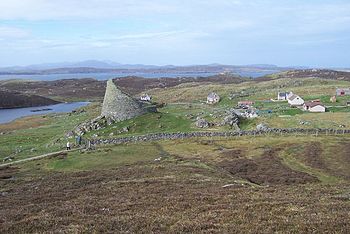
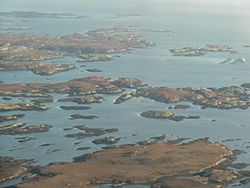
The Outer Hebrides are an island chain in the Atlantic Ocean, off the northwest coast of Great Britain. They are also known as the Long Island.
The Outer Hebrides are separated from the Inner Hebrides by the waters of the Minch, the Little Minch and the Sea of the Hebrides, and form a distinct archipelago, in a chain from Lewis in the north to the tiny, scattered isles and skerries around Mingulay in the south. The largest island, Lewis with Harris, is the largest island of the British Isles after Great Britain and Ireland themselves.
There are 15 inhabited islands of the Outer Hebrides, which have a total population of about 26,500. There are more than 50 substantial uninhabited islands and many more minor isles, islets and rocks. Separated to the west from the island chain but considered part of the Outer Hebrides are the isles of St Kilda.
Gaelic was formerly the dominant language and remains widely spoken, although in some areas English-speakers form a majority. The island names however are mainly Norse in origin, for this was the heartland of the Kingdom of the Isles.
Broad view
The long history of these islands (and the need to build in stone in the absence of timber) have left to us several important prehistoric structures, many of which pre-date the first written references to the islands by Roman and Greek authors.
The Norse ruled Suðreyjar for over 400 years until sovereignty was transferred to Scotland by the Treaty of Perth in 1266. Control of the islands was then held by clan chiefs, principal of whom were the MacLeods, MacDonalds, Mackenzies and MacNeils. This is sparse land, poor of agriculture and throughout its history barely sustained the population. The Highland Clearances of the 19th century had a devastating effect on many communities and it is only in recent years that population levels have ceased to decline. Much of the land is now under local control and commercial activity is based on tourism, crofting, fishing, and weaving.
Sea transport is crucial and a variety of ferry services operate between the islands and to mainland Scotland. Modern navigation systems now minimise the dangers but in the past the stormy seas have claimed many ships. Worship, music and sport are important aspects of local culture, and there are numerous designated conservation areas to protect the natural environment.
Geography
The main islands form an archipelago of which the major islands include Lewis and Harris, North Uist, Benbecula, South Uist, and Barra.
Lewis and Harris has an area of 538,438 acres[1] and is the largest island in Scotland and the largest in the British Isles after Great Britain and Ireland.[2] It incorporates Lewis in the north, which is a part of Ross-shire and Harris in the south, part of Inverness-shire; Lewis and Harris are frequently referred to as individual islands, the Isle of Lewis and Isle of Harris, although geographically they share the one island and are joined by a land border. The united island has no common name in either English or Gaelic, hence the coinage of necessity; "Lewis with Harris".[3]
Lochs and lochans
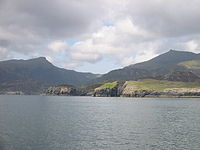
The largest islands are deeply indented by arms of the sea such as Loch Ròg, Loch Seaforth and Lochmaddy. There are also more than 7,500 freshwater lochs in the islands. North and South Uist and Lewis in particular have landscapes with a high percentage of freshwater and a maze and complexity of loch shapes.
Harris is the most mountainous island. It has fewer large bodies of water but innumerable small lochans.
On Lewis, Loch Langavat is seven miles long, and has several large islands in its midst, including Eilean Mòr. Although Loch Suaineabhal has only 25% of the Langavat's surface area it has a mean depth of 108 feet and is the most voluminous on the island.[4]
Of Loch Sgadabhagh on North Uist it has been said that "there is probably no other loch in Britain which approaches Loch Scadavay in irregularity and complexity of outline."[5] Loch Bì is South Uist's largest loch and at five miles long it all but cuts the island in two.[6]
Coast
Much of the western coastline of the islands is machair, a fertile low-lying dune pastureland.[7] Lewis is comparatively flat, and largely consists of treeless moors of blanket peat. The highest eminence is Mealisval at 1,883 feet in the south-west.
Most of Harris is mountainous, with large areas of exposed rock and Clisham, the archipelago's only “Corbett”, reaches 2,621 feet in height.[1]
North and South Uist and Benbecula, (sometimes collectively referred to as The Uists) have sandy beaches and wide cultivated areas of machair to the west and virtually uninhabited mountainous areas to the east. The highest peak here is Beinn Mhòr at 2,034 feet.[8] The Uists and their immediate outliers have a combined area of 288 square miles.[Note 1]
Barra is 23 square miles in extent and has a rugged interior, surrounded by machair and extensive beaches.[10][11]
Flora and fauna
Much of the archipelago is a protected habitat including both the islands and the surrounding waters. There are 53 Sites of Special Scientific Interest of which the largest are Loch an Duin, North Uist at 37,313 acres and North Harris, which is 31,382 acres in extent.[12][13]
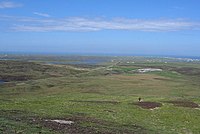
Loch Druidibeg on South Uist is a National Nature Reserve owned and managed by Scottish Natural Heritage. The reserve covers 4,144 acres across the whole range of local habitats.[14] Over 200 species of flowering plants have been recorded on the reserve, some of which are nationally scarce.[15] South Uist is considered the best place in the United Kingdom for the aquatic plant Slender Naiad, a protected species.[16][17]
Hedgehogs have become a rampant pest on the Uists. The animals are not native to the islands but were introduced in the 1970s to reduce garden pests; their spread since has posed a threat to the eggs of ground nesting wading birds. In 2003 Scottish Natural Heritage undertook culls of hedgehogs in the area although they were halted in 2007.
Nationally important populations of breeding waders are present in the Outer Hebrides including Common Redshank, Dunlin, Lapwing and Ringed Plover. The islands also provide a habitat for other important species such as Corncrake, Hen Harrier, Golden Eagle and Otter. Offshore, Basking Shark and various species of whale and dolphin can be seen regularly,[18] and the remoter islands' seabird populations are of international significance. St Kilda has 60,000 Northern Gannets, amounting to 24% of the world population, 49,000 breeding pairs of Leach's Petrel, up to 90% of the European population and 136,000 pairs of Puffin and 67,000 Northern Fulmar pairs, about 30% and 13% of the respective UK totals.[19] Mingulay is an important breeding ground for Razorbills, with 9,514 pairs, 6.3% of the European population.[20]
The bumblebee Bombus jonellus var. hebridensis is endemic to the Hebrides and there are local variants of the Dark Green Fritillary and Green-veined White butterflies.[21] The St Kilda Wren (T. t. hirtensis) is a subspecies of Wren confined to St Kilda.[22]
Islands
Populated islands
The inhabited islands had a total population of 26,502 at the time of the 2001 census. The largest settlement, and the only true town in the islands, is Stornoway on Lewis,[23] which has a population of about 8,100.[24]
The Isle of Lewis and its surrounding islands belong to Ross-shire. The rest of the archipelago, including the isle of Harris, belongs to Inverness-shire.
In addition to the North Ford (Oitir Mhòr) and South Ford causeways that connect North and South Uist, Benbecula, the northern of the two Grimsays, and several other islands can are accessible by causeways and bridges. Great Bernera and Scalpay have bridge connections to Lewis and Harris respectively, Baleshare and Berneray are linked to North Uist, Eriskay to South Uist, Flodaigh, Fraoch-eilean and the southern Grimsay to Benbecula, and Vatersay to Barra by causeways.[6][25][26] This means that all the inhabited islands are now connected to at least one other island by a land transport route.
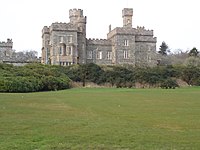
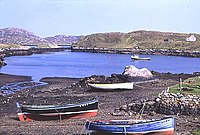
| Island | Gaelic name | Norse name | Population (2011) |
|---|---|---|---|
| Lewis | Leòdhas | Ljoðahús | |
| Great Bernera | Bearnaraigh Mòr | Bjarnarøy | 233 |
| Harris | Hearadh | Haerri? | |
| Berneray | Beàrnaraigh | 136 | |
| Scalpay | Sgalpaigh | Skalprøy | 322 |
| North Uist | Uibhist a Tuath | Ívist | 1,271 |
| Baleshare | Baile Sear | 49 | |
| Grimsay | Griomasaigh | Grimsey | 201 |
| Benbecula | Beinn nam Fadhla | 1,219 | |
| Grimsay (south) | Griomasaigh | Grimsey | 19 |
| South Uist | Uibhist a Deas | Ívist | 1,818 |
| Eriskay | Eirisgeidh | Eiriksey | 133 |
| Vatersay | Bhatarsaigh | Vatersey | 94 |
| Barra | Barraigh | 1,078 | |
| Flodaigh | Flodaigh | Flotey | 11 |
Uninhabited islands
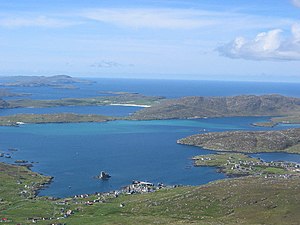
There are more than fifty uninhabited islands greater in size than 99 acres in the Outer Hebrides, including the:
- Barra Isles
- Flannan Isles
- Monach Islands
- Shiant Isles and
- The islands of Loch Ròg.[27]
In common with the other main island chains of Scotland, many of the more remote islands were abandoned during the 19th and 20th centuries, in some cases after continuous habitation since the prehistoric period. More than 35 such islands have been identified in the Outer Hebrides alone.[28][Note 2]
Some of the smaller islands continue to contribute to modern culture. The "Mingulay Boat Song", although evocative of island life, was written long after the abandonment of the island in 1938 (the island is invoked just to get the line to scan) and Taransay hosted the BBC television series ‘’Castaway 2000’’. Others have played a part in history. On 4 May 1746, the "Young Pretender" Charles Edward Stuart hid on Eilean Liubhaird with some of his men for four days while Royal Navy vessels patrolled the Minch.[30]
Smaller isles and skerries and other island groups pepper the North Atlantic surrounding the main islands, which may not be geologically part of the Outer Hebrides;
- St Kilda lies to the west of Harris, now uninhabited except for a small military base
- North Rona and Sula Sgeir to the north of Lewis are small and remote islands.
- Rockall is further into the Atlantic
While Rona used to support a small population who grew grain and raised cattle, Sula Sgeir is an inhospitable rock. Thousands of gannets nest here, and by special arrangement some of their young, known as gugas are harvested annually by the men of Ness.
Names
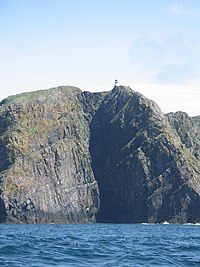
The earliest written references that have survived relating to the islands were made by Pliny the Elder in his Natural History, where he states that there are 30 "Hebudes", and makes a separate reference to "Dumna", which Watson (1926) concludes is unequivocally the Outer Hebrides. Writing about 80 years later, in AD 140-150, Ptolemy, drawing on the earlier naval expeditions of Agricola, also distinguished between the Ebudes, of which he writes there were only five (and thus possibly meaning the Inner Hebrides) and Dumna.[31][32] Dumna is cognate with the Early Celtic dumnos and means the "deep-sea isle". Breeze also suggests that Dumna might be Lewis with Harris, the largest island of the Outer Hebrides. Murray (1966) claims that Ptolemy's "Ebudae" was originally derived from the Old Norse Havbredey, meaning "isles on the edge of the sea". This idea is often repeated but no firm evidence of this derivation has emerged.[33]
Other early written references include the flight of the Nemed people from Ireland to "Domon", which is mentioned in the 12th century Lebor Gabála Érenn and a 13th century poem concerning Ragnald Guthfithsson, then the heir to the throne of Mann and the Isles, who is said to have "broken the gate of Magh Domhna", but the precise meaning of the text is not clear.[32][32]
In Irish mythology the islands were the home of the Fomorians, described as "huge and ugly" and "ship men of the sea". They were pirates, extracting tribute from the coasts of Ireland and one of their kings was Indech mac Dé Domnand (i.e. Indech, son of the goddess Domnu, who ruled over the deep seas).[34]
In modern Gaelic the islands are sometimes referred to collectively as An t-Eilean Fada (the Long Island)[35] or Na h-Eileanan a-Muigh (the Outer Isles).[36] Innse Gall (islands of the foreigners or strangers) is also heard occasionally, a name that was originally used by mainland Highlanders when the islands were ruled by the Norse.[37]
The individual island and place names in the Outer Hebrides have mixed Gaelic and Norse origins.
Geology
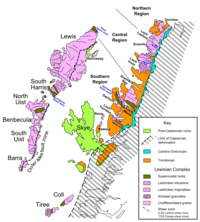
Most of the islands have a bedrock formed from Lewisian gneiss, which amongst the oldest rocks in Britain and Europe, formed in the Precambrian period up to 3,000 million years ago. In addition to the Outer Hebrides, they form basement deposits on the mainland west of the Moine Thrust and on the islands of Coll and Tiree.[38] These rocks are largely igneous in origin, mixed with metamorphosed marble, quartzite and mica schist and intruded by later basaltic dykes and granite magma.[39] The gneiss's delicate pink colours are exposed throughout the islands and it is sometimes referred to by geologists as "The Old Boy".[35]
Granite intrusions are found in the parish of Barvas in west Lewis, and another forms the summit plateau of the mountain Roineabhal in Harris. The granite here is anorthosite, and is similar in composition to rocks found in the mountains of the Moon. There are relatively small outcrops of Triassic sandstone at Broad Bay near Stornoway. The Shiant Isles and St Kilda are formed from much later tertiary basalt and basalt and gabbros respectively.
Climate
The Outer Hebrides are exposed to the worst the Atlantic storms can throw at them, a punished landscape reflected in the torn rocks and coastline. Nevertheless, for much of the year they have a cool temperate climate, remarkably mild and steady for such a northerly latitude, due to the influence of the Gulf Stream.
The summer days are relatively long and May to August is the driest period.[40] Winds are a key feature of the climate and even in summer there are almost constant breezes. According to the writer W H Murray if a visitor asks an islander for a weather forecast "he will not, like a mainlander answer dry, wet or sunny, but quote you a figure from the Beaufort Scale."[41]
There are gales one day in six at the Butt of Lewis and small fish are blown onto the grass on top of 620 foot high cliffs at Barra Head during winter storms.[42]
Prehistory
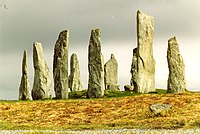
The Hebrides were originally settled in the Mesolithic era and have a diversity of important prehistoric sites. Eilean Dòmhnuill in Loch Olabhat on North Uist was constructed circa 3200-2800 BC and may be Scotland's earliest crannog.[43][44]
The Callanish Stones dating from about 2900 BC are the finest example of a stone circle in the north. The 13 primary monoliths of between one and five yards high creating a circumference about 43 feet in diameter.[45][46][47]
Cladh Hallan on South Uist, the only site in the United Kingdom where prehistoric mummies have been found and the impressive ruins of Dun Carloway broch on Lewis both date from the Iron Age.[48][49][50]
Economy
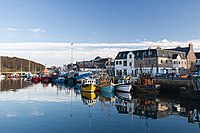
Modern commercial activities centre on tourism, crofting, fishing, and weaving including the manufacture of Harris tweed. Some of the larger islands have development trusts that support the local economy and, in striking contrast to the 19th and 20th century domination by absentee landlords, more than two thirds of the Western Isles population now lives on community-owned estates.[51][52] However the economic position of the islands remains relatively precarious. The Western Isles, including Stornoway, are defined by Highlands and Islands Enterprise as an economically "Fragile Area" and they have an estimated trade deficit of some £163.4 million. Overall, the area is relatively reliant on primary industries and the public sector, and fishing and fish farming in particular are vulnerable to environmental impacts, changing market pressures and European legislation.[53]
There is some optimism about the possibility of future developments in for example, renewable energy generation, tourism, and education, and after declines in the 20th century the population has stabilised since 2003, although it is ageing.[53][54]
Gaelic language
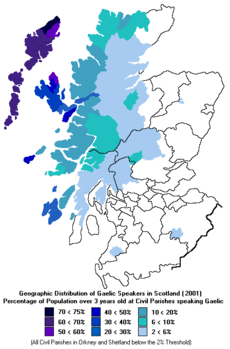
The Outer Hebrides have historically been a very strong Gaelic-speaking area. Both the 1901 and 1921 census reported that all parishes were over 75% Gaelic speaking, including areas of high population density such as Stornoway. The Education (Scotland) Act 1872 led to generations of Gaels being forbidden to speak their native language in the classroom, and this is now recognised as having dealt a major blow to the language. People still living can recall being beaten for speaking Gaelic in school.[55][56] Nonetheless, by 1971 most areas were still more than 75% Gaelic speaking – with the exception of Stornoway, Benbecula and South Uist at 50-74%.[57]
In the 2001 census, each island overall was over 50% Gaelic speaking – South Uist (71%), Harris (69%), Barra (68%), North Uist (67%), Lewis (56%) and Benbecula (56%). With 59.3% of Gaelic speakers or a total of 15,723 speakers, this made the Outer Hebrides the most strongly coherent Gaelic speaking area in Scotland.[57][58]
Most areas are between 60-74% Gaelic speaking and the areas with the highest density of over 80% are Scalpay near Harris, Newtonferry and Kildonan, whilst Daliburgh, Linshader, Eriskay, Brue, Boisdale, West Harris, Ardveenish, Soval, Ness, and Bragar all have more than 75%. The areas with the lowest density of speakers are Stornoway (44%), Braigh (41%), Melbost (41%), and Balivanich (37%).[57]
Transport
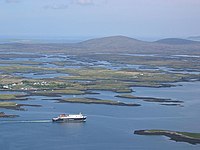
Scheduled ferry services between the Outer Hebrides and mainland Great Britain and the Inner Hebrides operate on the following routes:
- Oban to Castlebay on Barra and Lochboisdale on South Uist
- Uig on Skye to Tarbert on Harris
- Uig on Skye to Lochmaddy on North Uist
- Ullapool to Stornoway on Lewis
- Tiree to Castlebay, Barra (summer only).
Other ferries operate between some of the islands.[59]
There are scheduled flights from Stornoway, Benbecula and Barra airports both inter-island and to the mainland. Barra's airport is the only one in the world to have scheduled flights landing on a beach. At high water the runways are under the sea so flight times vary with the tide.[60][61]
Outside links
| ("Wikimedia Commons" has material about Outer Hebrides) |
- Stornoway Port Authority
- 2001 Census Results for the Outer Hebrides
- Hebrides.com Photographic website from ex-Eolas Sam Maynard
- Global Guide Hebrides Content website from ex-Eolas Scott Hatton
- www.visithebrides.com Western Isles Tourist Board site from Reefnet
- Virtual Hebrides.com Content from the VH, which went its own way and became Virtual Scotland.
- hebrides.ca Home of the Quebec-Hebridean Scots who were cleared from Lewis to Quebec 1838-1920's
References
- ↑ The quoted area figure includes the Uists themselves and the islands that link to them by causeways and bridges.[9]
- ↑ On Barra Head, for example, Historic Scotland have identified eighty-three archaeological sites on the island, the majority being of a pre-mediæval date. In the 18th century the population was over fifty, but the last native islanders had left by 1931. The island became completely uninhabited by 1980 with the automation of the lighthouse.[29]
- ↑ 1.0 1.1 Haswell-Smith (2004) p. 289
- ↑ Haswell-Smith (2004) p. 262
- ↑ Thompson (1968) p. 13
- ↑ Murray and Pullar (1910) "Lochs of Lewis" Page 216, Volume II, Part II. National Library of Scotland. Retrieved 21 December 2009.
- ↑ Murray and Pullar (1910) "Lochs of North Uist" Page 188, Volume II, Part II. National Library of Scotland. Retrieved 20 December 2009.
- ↑ 6.0 6.1 "Get-a-map". Ordnance Survey. Retrieved 1–15 August 2009.
- ↑ Murray (1966) pp. 171, 198
- ↑ Haswell-Smith (2004) pp. 236-45
- ↑ Haswell-Smith (2004) p. 206
- ↑ Rotary Club (1995) p. 106
- ↑ Haswell-Smith (2004) pp. 218-22
- ↑ "Western Isles Transitional Programme Strategy" Comhairle nan Eilean Siar. Retrieved 19 May 2010.
- ↑ Rotary Club (1995) p. 10
- ↑ "Loch Druidibeg National Nature Reserve: Where Opposites Meet". (pdf) SNH. Retrieved 29 July 2007.
- ↑ "South Uist and Eriskay attractions" isle-of-south-uist.co.uk. Retrieved 5 July 2010.
- ↑ "Higher plant species: 1833 Slender naiad" JNCC. Retrieved 29 July 2007.
- ↑ "Statutory Instrument 1994 No. 2716 " Office of Public Sector Information. Retrieved 5 July 2010.
- ↑ "Western Isles Biodiversity: Biodiversity Audit - Main report" Comhairle nan Eilean Siar. Retrieved 5 July 2010.
- ↑ Benvie (2004) pp. 116, 121, 132–34
- ↑ "Mingulay birds". National Trust for Scotland. http://www.nts-seabirds.org.uk/properties/mingulay/mingulay_breeding.aspx/. Retrieved 16 February 2007.
- ↑ Thompson (1968) p. 21
- ↑ Maclean (1972) p. 21
- ↑ General Register Office for Scotland (2003)
- ↑ Haswell-Smith (2004) p. 296
- ↑ "Fleet Histories" Caledonian MacBrayne. Retrieved 3 August 2009.
- ↑ Haswell-Smith (2004) pp. 205, 253
- ↑ Haswell-Smith (2004) pp. 206, 262
- ↑ Haswell-Smith (2004) various pages
- ↑ Haswell-Smith (2004) pp. 207-209
- ↑ Haswell-Smith (2004) pp. 282–83
- ↑ Breeze, David J. "The ancient geography of Scotland" in Smith and Banks (2002) pp. 11-13
- ↑ 32.0 32.1 32.2 Watson (1926) pp. 40-41
- ↑ Murray (1966) p. 1
- ↑ Watson (1926) pp. 41-42 quoting Lebor na hUidre and the Book of Leinster.
- ↑ 35.0 35.1 Murray (1966) p. 2
- ↑ "The Gaelic—English Dictionary" Bookrags.com. Retrieved 1 May 2010.
- ↑ Hunter (2000) p. 104
- ↑ Gillen (2003) p. 44
- ↑ McKirdy et al. (2007) p. 95
- ↑ Thompson (1968) pp. 24-26
- ↑ Murray (1973) p. 79
- ↑ Murray (1973) pp. 79-81
- ↑ Armit (1998) p. 34
- ↑ Crone, B.A. (1993) "Crannogs and chronologies" (pdf) Proceedings of the Society of Antiquarians of Scotland. 123 pp. 245-54. Retrieved 1 May 2008.
- ↑ Li (2005) p. 509
- ↑ Murray (1973) p. 122
- ↑ "Lewis, Callanish, 'Tursachan' " RCAHMS. Retrieved 21 April 2008.
- ↑ "Mummification in Bronze Age Britain" BBC History. Retrieved 11 February 2008.
- ↑ "The Prehistoric Village at Cladh Hallan". University of Sheffield. Retrieved 21 February 2008.
- ↑ "AD 200 - Valtos: brochs and wheelhouses" archaeology.co.uk Retrieved 1 August 2009.
- ↑ "Directory of Members" DTA Scotland. Retrieved 15 July 2007.
- ↑ "The quiet revolution". (19 January 2007) West Highland Free Press. Broadford, Skye.
- ↑ 53.0 53.1 "Factfile - Economy" Comhairle nan Eilean Siar. Retrieved 4 July 2010.
- ↑ "Factfile - Population" Comhairle nan Eilean Siar. Retrieved 4 July 2010.
- ↑ "Gaelic Education After 1872" simplyscottish.com. Retrieved 28 May 2010.
- ↑ Morris (2001) p. 416
- ↑ 57.0 57.1 57.2 Mac an Tàilleir, Iain (2004) 1901-2001 Gaelic in the Census Linguae Celticae. Retrieved 01 June 2008
- ↑ "Census 2001 Scotland: Gaelic speakers by council area" Comunn na Gàidhlig. Retrieved 28 May 2010.
- ↑ "Timetables and Fares" Caledonian MacBrayne. Retrieved 4 July 2010.
- ↑ "Barra Airport". Highlands and Islands Airports Limited. http://www.hial.co.uk/barra-airport.html. Retrieved 6 April 2009.
- ↑ "Barra Airport". Undiscovered Scotland. http://www.undiscoveredscotland.co.uk/barra/airport/index.html. Retrieved 8 July 2010.
- Armit, Ian (1998) Scotland's Hidden History. Tempus (in association with Historic Scotland). ISBN 0-7486-6067-4
- Ballin Smith, B. and Banks, I. (eds) (2002) In the Shadow of the Brochs, the Iron Age in Scotland. Stroud. Tempus. ISBN 075242517X
- Ballin Smith, Beverley; Taylor, Simon; Williams, Gareth (eds) (2007) West Over Sea: Studies in Scandinavian Sea-Borne Expansion and Settlement Before 1300. Leiden. Koninklijke Brill. ISBN 9789004158931
- Benvie, Neil (2004) Scotland's Wildlife. London. Aurum Press. ISBN 1854109782
- Buxton, Ben (1995) Mingulay: An Island and Its People. Edinburgh. Birlinn. ISBN 1874744246
- Downham, Clare (2007) Viking Kings of Britain and Ireland: The Dynasty of Ívarr to A.D. 1014. Edinburgh. Dunedin Academic Press. ISBN 9781903765890
- Gillen, Con (2003) Geology and landscapes of Scotland. Harpenden. Terra Publishing. ISBN 1903544092
- Gregory, Donald (1881) The History of the Western Highlands and Isles of Scotland 1493 - 1625. Edinburgh. Birlinn. 2008 reprint - originally published by Thomas D. Morrison. ISBN 1904607578
- Hanson, William S. "The Roman Presence: Brief Interludes", in Edwards, Kevin J. & Ralston, Ian B.M. (Eds) (2003) Scotland After the Ice Age: Environment, Archaeology and History, 8000 BC - AD 1000. Edinburgh. Edinburgh University Press.
- Haswell-Smith, Hamish. (2004) The Scottish Islands. Edinburgh. Canongate. ISBN 1-84195-454-3
- Hunter, James (2000) Last of the Free: A History of the Highlands and Islands of Scotland. Edinburgh. Mainstream. ISBN 1840183764
- Keay, J. & Keay, J. (1994) Collins Encyclopaedia of Scotland. London. HarperCollins. ISBN 0002550822
- Mac an Tàilleir, Iain (2003) Placenames/Ainmean-àite le buidheachas (pdf). Pàrlamaid na h-Alba. Retrieved 6 October 2009.
- McKirdy, Alan Gordon, John & Crofts, Roger (2007) Land of Mountain and Flood: The Geology and Landforms of Scotland. Edinburgh. Birlinn. ISBN 9781841583570
- Maclean, Charles (1977) Island on the Edge of the World: the Story of St. Kilda. Edinburgh. Canongate. ISBN 0903937417
- Malhotra, R. (1992) Anthropology of Development: Commemoration Volume in Honour of Professor I.P. Singh. New Delhi. Mittal. ISBN 8170993288
- Li, Martin (2005) Adventure Guide to Scotland. Hunter Publishing. Retrieved 19 May 2010.
- Miers, Mary (2008) The Western Seaboard: An Illustrated Architectural Guide. The Rutland Press. ISBN 9781873190296
- Murray, Sir John and Pullar, Laurence (1910) Bathymetrical Survey of the Fresh-Water Lochs of Scotland, 1897-1909. London. Challenger Office.
- Murray, W H (1966) The Hebrides. London. Heinemann.
- Murray, W H (1973) The Islands of Western Scotland: the Inner and Outer Hebrides. London. Eyre Methuen. ISBN 0413303802
- Ross, David (2005) Scotland - History of a Nation. Lomond. ISBN 0947782583
- Rotary Club of Stornoway (1995) The Outer Hebrides Handbook and Guide. Machynlleth. Kittwake. ISBN 0951100351
- Thompson, Francis (1968) Harris and Lewis, Outer Hebrides. Newton Abbot. David & Charles. ISBN 0715342606
